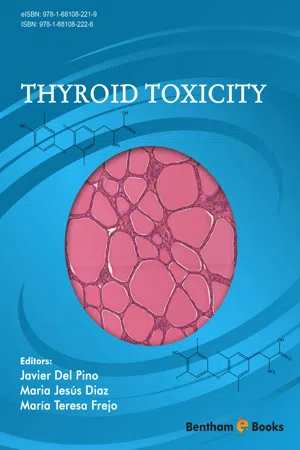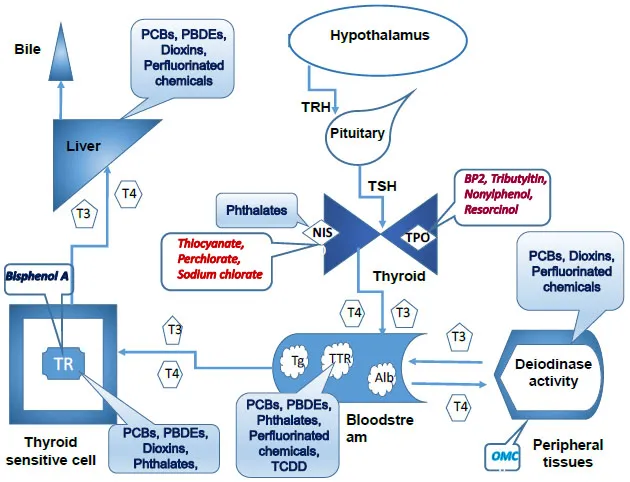INTRODUCTION
In the last 50 years, industrial compounds’ toxicity and hazards to public health have been shown by clinical studies [1], especially due to their structural similarity to hormones [2 - 4]. The thyroid system is one of the most affected endocrine systems. Thyroid hormones have a key role in numerous physiological processes such as metabolic regulation, bone remodeling, cardiac function and mental state. So maintaining normal function of the thyroid gland for psychological and physiological well-being is essential [5].
Thyroid hormones are especially important in fetal development, especially in the development of the nervous system, which depends on the normal levels of these
hormones, and it has been observed that their deficiency reduces neuronal growth and differentiation in the cerebral cortex, hippocampus and cerebellum [6, 7]. Therefore, an alteration of the thyroid system could have harmful effects on physiology and development of the whole organism.
Thyroid disrupter industrial chemicals include a wide range of chemical structures acting through different mechanisms (Fig. 1), which have been studied in experimental animals [8, 9]. Moreover, there is also evidence of their effects by alteration of thyroid hormone homeostasis in humans [10, 11]. However, there are a number of uncertainties in the interpretation of study results in animals and in the extrapolation of these results to humans [12, 13] as well as in the variety of mechanisms of action through which alteration in TH levels is caused.
The aim of this chapter is to provide a review of the existing data on how industrial chemicals disrupt the thyroid system based on their mechanisms of action in order to highlight the risks inherent to human and animal health due to the short and long term use of these products.
INDUSTRIAL CHEMICALS THAT DISRUPT THE THYROID SYSTEM ONLY THROUGH ONE MECHANISM OF ACTION
Inhibition of Iodide Uptake into the Thyrocyte Cell Membrane by Blocking the NIS Carrier
The first step in the biosynthesis of thyroid hormones is iodide uptake from the bloodstream and its transport against a gradient across the lumen follicular cells by the sodium/iodide symporter (NIS) protein [14]. NIS is capable of carrying other anions besides iodide, such as thiocyanate (SCN), perchlorate (ClO4-) and sodium chlorate (NaClO3), which inhibit the accumulation of iodine in the thyroid gland by competition with said anion.
Thiocyanate
Although thiocyanate is not an industrial compound itself, cigarette smoke contains cyanide that is metabolized to thiocyanate in the body, which can decrease the absorption of iodine in the thyroid by competitive inhibition of NIS [15]. Blocking the iodide uptake mechanism has a similar effect to iodine deficiency. In this regard, blood levels of thyroxine (T4) and triiodothyronine (T3) are decreased, causing a compensatory increase in the secretion of thyroid-stimulating hormone (TSH) from the pituitary gland, which produces hypertrophy and hyperplasia of the follicular cell with an elevation thyroid weight and development of goiter [16].
On the other hand, newborn babies from mothers who smoked during pregnancy are more likely to have low serum T4 [17], increased levels of TSH, thyroid enlargement [18, 19] and low iodine levels in both mothers and their babies [20]. These effects have been hypothesized to be related to thiocyanate exposure. This is a cause of concern due to the fact that THs are needed for normal neurological development. Further studies are needed to confirm this hypothesis and determine the implication of this compound in thyroid disruption of the smoker population.
Perchlorate
Perchlorates occur both naturally and through manufacturing, used as a rocket propellant, in the preparation of explosives, fireworks, flares, airbag deployment systems, commercial fertilizers and by pharmaceutical industries [21]. Perchlorate is an ion that could affect thyroid function because it competitively inhibits iodine transport in thyroid follicular cells through inhibition of NIS [22, 23]. Therefore, it could induce hypothyroidism in different stages of life [24 - 26].
Experimental studies in animals provide strong evidence that perchlorates could alter thyroid homeostasis [27]. However, human studies remain controversial. In this regard, Blount and coworkers [28] settled a relationship between the presence of perchlorates in blood and urine, and TSH (positive association) and total T4 (negative association) levels, especially in women with a urinary iodide level of <100 mg/L. In contrast, other studies of perchlorate exposure have not determined a substantial relationship to thyroid parameters. In this sense, no effects on thyroid function including iodide uptake, serum thyroid hormones, TSH and thyroglobulin have been reported in healthy volunteers after 6 months of exposure to perchlorate in doses up to 3 mg/day [29]. Moreover, thyroid gland iodine uptake in workers in an ammonium perchlorate generation plant was negatively correlated with their presence at work [30]. Therefore, it remains doubtful whether environmentally occurring levels of perchlorate have any effects on humans.
Finally, the National Research Council in 2005 concluded that perchlorate exposure could produce TSH and TH disruption followed by hypertrophy and hyperplasia of the follicular cells [31]. Hypothyroidism could be developed only in people who fail to compensate for the perchlorate effect with an increase in iodine uptake. The Committee, based on clinical, occupational, environmental and epidemiological studies, recommended a reference dose of 0.0007 mg/kg/day of iodine, which should protect health in most sensitive populations [31].
Sodium Chlorate (NaClO3)
Sodium chlorate is utilized as an oxidizing agent in dyes, explosives, matches, and leather industries. It is also found as a drinking water disinfection by-product after chlorine dioxide disinfection [32]. It causes thyroid system disruption through inhibition of the sodium/iodide cotransporter. The toxicity data for NaClO3 are reduced and come primarily from subchronic studies. In this regard, Bercz and coworkers [33] described a concentration-dependent reduction in T4 levels in African green monkeys. Moreover, McCauley and coworkers [34] reported thyroid gland colloid depletion after NaClO3 subchronic exposure in rats. Furthermo...

